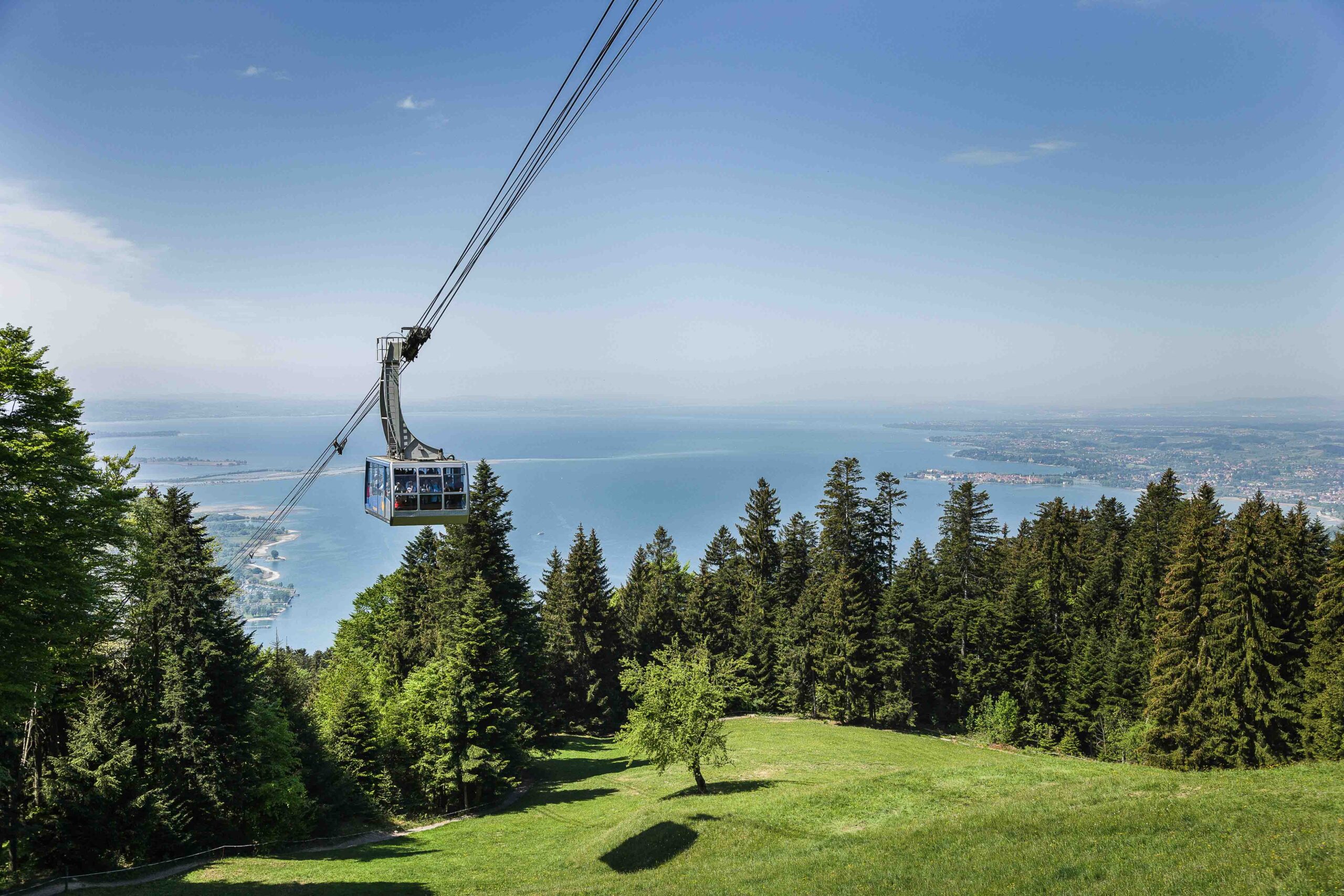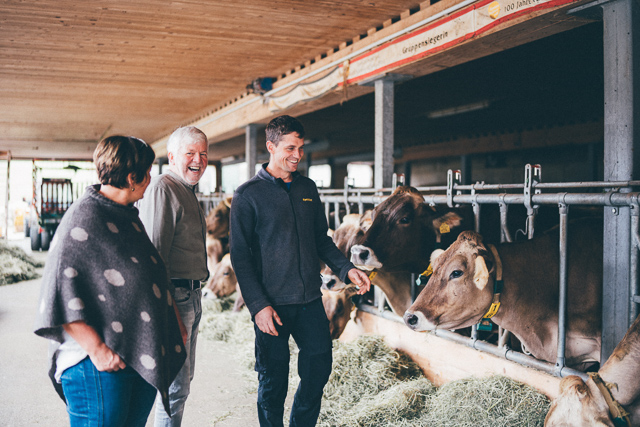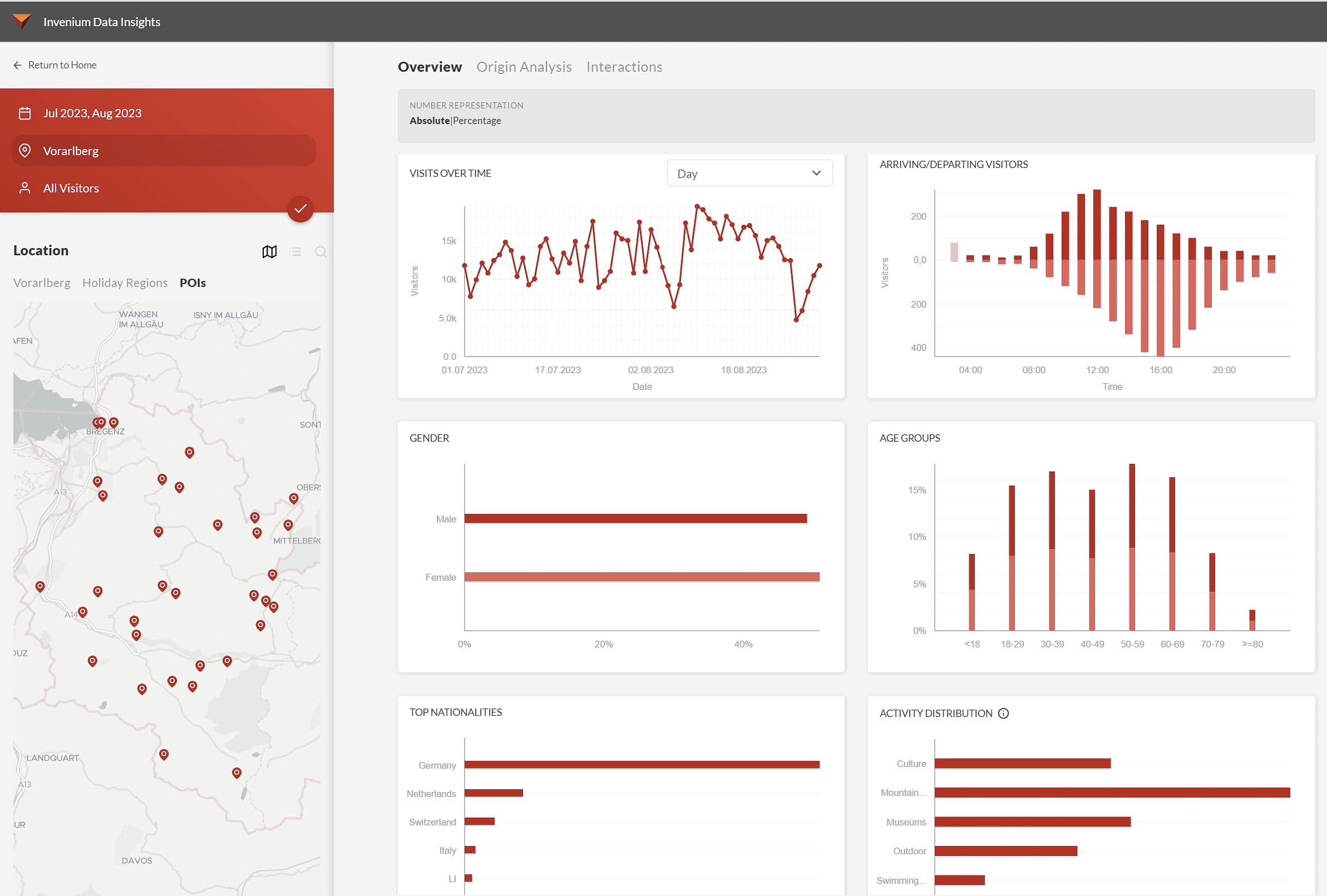Net-positive trips to Vorarlberg
How might we use AI to foster net-positive trips to Vorarlberg?

Net-positive tourism
Vorarlberg Tourismus promotes sustainable tourism and is committed to helping visitors explore and enjoy our region in an environmentally friendly way. The pursuit of sustainable tourism presents ongoing challenges due to our fragile ecosystems, rich cultural heritage, economic dependence on tourism, seasonal fluctuations, and transportation constraints. Travelers are increasingly looking for more sustainable travel choices. Balancing conservation with economic development and cultural preservation requires innovative solutions and stakeholder collaboration to minimize environmental impacts, preserve local identity, and promote responsible tourism practices for long-term sustainability.
To address this challenge, let’s imagine net-positive trips to Vorarlberg. Net-positive refers to activities or practices that not only minimize negative impacts but actively contribute to positive outcomes for the environment, local communities, and cultural heritage. It means going beyond sustainability by ensuring that the benefits of an action outweigh any potential harm, resulting in a net gain for society and the planet.
Three actors taking steps towards net-positive tourism
In Vorarlberg, several actors are already taking steps towards net-positive. For this challenge, we have selected three of them, focusing on different aspects of net-positive trips.
– How to get there (mobility): Bahn zum Berg contributes to protecting the Alps. The nonprofit organization focuses on showing where and how sustainable travel to mountain experiences is possible
– Where to stay (accommodation): Urlaub am Bauernhof offers an authentic Austrian farm holiday, combining agriculture and tourism for a sustainable, immersive experience with local farmers, direct farm-to-table food, nature adventures, and serene retreats in picturesque rural settings.
– What to do (activities): Impact Steps inspires activity providers to create unique experiences with a positive impact to foster the sustainability of destinations.
Potential of data ecosystems & AI
Data is fundamental to tourism’s sustainable transformation, enabling informed decision-making, performance monitoring, and stakeholder engagement. By analyzing data on resource use, visitor behavior, and environmental impact, destinations can identify areas for improvement and track progress toward sustainability goals, fostering innovation, accountability, and transparency within the tourism industry.
However, the data landscape in tourism destinations such as Vorarlberg is highly fragmented. The system landscape has grown historically, and data is stored in many data silos with different service providers. Access to this data and the associated data sovereignty lies with different tourism or external stakeholders. A seamless and sustainable guest experience is compromised by a lack of collaboration between stakeholders (tourism associations, accommodation providers, cable cars, authorities, mobility providers and retailers). For example, convenient and sustainable last-mile mobility solutions are hampered by a lack of data exchange across national borders and mobility providers. Mobility offers are rarely combined with accommodation or activities of guest cards and product bookings.
The V-Cloud managed by Vorarlberg Tourism aims to solve this problem. It serves as a central database for high-quality tourism data, including images, videos, maps and cultural offerings. It aims to collect and manage relevant information from different partner networks, ensuring reliable quality through standardized criteria. The V-Cloud enables the distribution of tourism information across multiple applications and platforms. For this challenge you get access to the V-Cloud and its API, to develop innovative applications that promote sustainable tourism. Use the extensive data from the V-Cloud to create solutions that encourage travelers to make environmentally friendly decisions and contribute to local communities.
The emergence of AI enhances the value of data ecosystems by automating data collection, quickly analyzing large data sets, uncovering patterns, and generating predictive insights. AI increases the strategic value of data as a transformative asset.
Your challenge
We encourage you to come up with AI-powered ideas to contribute to net-positive tourism in Vorarlberg. Your idea can either tackle the overall challenge of how we might we leverage AI to promote net-positive trips to Vorarlberg, or you can choose a specific problem from one of the challenge partners.
How to get there by Bahn zum Berg

The problem
Last-mile services have proliferated in recent years. In addition to cable cars, many hiking buses, on-demand taxis, etc., have been added.
Cable cars and hiking buses are not new. On-demand taxis are a product of recent years. Walking buses in particular have a problem: they are only known regionally. What’s more, they only operate for a limited period – usually during the summer months. It is difficult for someone who has not been informed by the local tourist office about the times and destinations of the hiking bus, e.g. someone who lives further away, to get the information.
It is a little easier with a cable car because it usually runs regularly and is marked on (hiking) maps. An internet search usually leads to the timetable. The bus station is usually called the same as the cable car station, which makes it easy to plan your trip by public transport.
All last-mile services would benefit from machine-processable schedules that could be used by mobile solutions and apps. This would allow Google Maps to treat and display all these services like trains and buses. The same goes for Zuugle: All trips that start at stops for these mobility services would be visible as public transportation trips. Other applications that can use this data are only a matter of time. With more visibility and better planning for customers, the likelihood of new customers increases. We suggest focusing on cable cars because their complexity is manageable: they have a starting point, an endpoint, and an optional intermediate station.
How might we (semi-)automatically collect cable car travel times and master data so that navigation apps can use the data to facilitate sustainable travel to mountain experiences in Vorarlberg?
Your solutions
The goal of this challenge is to automate the existing solution for generating standardized timetable data for last-mile mobility services. The focus is on the collection of target timetable data from cable cars in GTFS format. Master data (e.g. geocoordinates of stops, website, company name, etc.) is collected either automatically or manually. The times are automatically read from an API or the operator’s website. This automatic filling provides a cost-effective (because it saves resources) way to collect the target schedule data. This means that the end result, the GTFS files, can be published in an open-source model. This increases the likelihood of further possible applications and good solutions, which ultimately leads to more people learning about the mobility solutions and thus more people using them, which ultimately contributes to SDG 13 “Improve CO2 emissions per passenger kilometer in local public transport”.
Where to stay by Urlaub am Bauernhof

The problem
In Vorarlberg and Austria, farm vacations are a niche segment. Although a farm vacation offers sustainable and meaningful experiences, awareness of this great vacation offer is not yet sufficiently widespread. Many potential travelers are not aware of the unique benefits and the special vacation experience. Difficulties in attracting travelers might result from misconceptions about the lack of modern amenities, limited accessibility to farms, and insufficient visibility. We need to overcome prejudices like smell, noise, and dirt.
How might we use AI to inspire more travelers to take farm holidays in Vorarlberg?
Your solutions
To solve this problem, we want to use AI to increase the visibility of “Urlaub am Bauernhof” in Vorarlberg and inspire more travelers to book. How can we attract guests from the DACH region and Benelux countries? How can we boost the visibility of the 126 farms in Vorarlberg? How can we raise awareness of high-quality farm products, such as milk, cheese, butter, and yogurt? How can we make our offer more appealing to younger travelers, couples, seniors, or solo travelers?
The focus is on showcasing the diverse and meaningful experiences on offer visible and communicating the sustainability that is practiced. For example, farmers play a key role in maintaining the landscape, making activities like skiing and hiking possible. Your ideas should promote a unique, sustainable and meaningful vacation experience and meet the modern needs of travelers. Remember, we are inviting travelers to disconnect, and technology should not interfere with the meaningful experience travelers can have while traveling. The Austrian Farm Holiday Association already uses a professional online booking platform (Seekda) to provide technical support for access to this vacation experience.
What to do by Impact Steps

The Problem
Travel activities such as sightseeing, tours, or outdoor activities can play a dual role: On the one hand, they have the potential to create value from local resources such as biodiversity, landscape, and cultural heritage and foster economic prosperity. On the other hand, they can increase the risks of environmental degradation and biodiversity loss, harm local communities, or lead to economic leakages. However, providing more sustainable travel experiences is a challenge for activity providers. The difficulties often lie in implementing sustainable practices, especially when these conflict with economic realities and customer demands. Investing in further developing offerings to minimize environmental and social impacts requires significant resources and is often at odds with short-term economic goals. Furthermore, balancing authenticity and sustainable standards is challenging as travelers seek authentic and enriching experiences without compromising the environment and local communities.
AI offers a groundbreaking opportunity to curate a comprehensive knowledge base on sustainability and local experiences for fostering net-positive travel activities. By leveraging advanced algorithms and machine learning, AI can analyze diverse data sources, including environmental reports and cultural heritage, to provide actionable insights and personalized recommendations. Additionally, AI enables real-time monitoring of environmental indicators and community well-being, empowering stakeholders to optimize sustainable tourism strategies for long-term resilience. The challenge is to harness AI to facilitate the experience design of net-positive travel activities.
How might we use AI to inspire travel activity providers to design net-positive activities in Vorarlberg?
Your solutions
Solutions for the activity problem of the challenge can focus on the experience design process. How can we curate a knowledge base with a wide range of relevant data and insights to feed the Large Language Model and support the experience design of activity providers? What if activity providers and nonprofits could be matched to partner for a fun and impactful activity? How could AI facilitate communication and collaboration among stakeholders, including destination management organizations, local communities, and businesses, to ensure that travel activities align with sustainable goals?
Other ideas could explore reviews or reporting: AI can analyze customer feedback to improve the sustainability and appeal of activity offerings? How can AI automate the generation of sustainability reports, highlighting the positive and negative impacts of tourism activities?
Finally, you can focus on the traveler’s decision and behavior by investigating AI could inform and educate travelers about the importance of sustainable travel practices, responsible behavior and ways to support local communities.
Leverage movement data by Invenium

To tackle this challenge, you can use the data provided by Invenium. With “Mobility Insights”, Invenium creates a new view of human movement flows and patterns using state-of-the-art algorithmic models, powerful Big Data technologies and artificial intelligence on anonymized mobile signaling data.
The basis for “Mobility Insights” is technical data, so-called cell phone signaling data, which a cell phone provider generates to maintain its infrastructure. In Austria, Invenium and A1 use a strictly TÜV-tested process to reprocess around 3.2 million mobile device data every day, to make them anonymous and to aggregate them to such an extent that it is not possible to trace them back to individual persons. The data, which amount about 44% of the total population in Austria, are extrapolated to the rest of the population. Therefore special mathematical and statistical methods are used. you will find the information to get access to the data on Slack.
How might movement data contribute to net-positive trips to Vorarlberg?
Collaboration incentives
The best net-positive trip solution will win tickets to the Tourism Technology Festival ( 9-10 November 2024, in Salzburg), where you can take their prototype to the next level. Our challenge partners will support you with data and expertise. You can expect great food, an inspiring environment, and a vibrant community.


